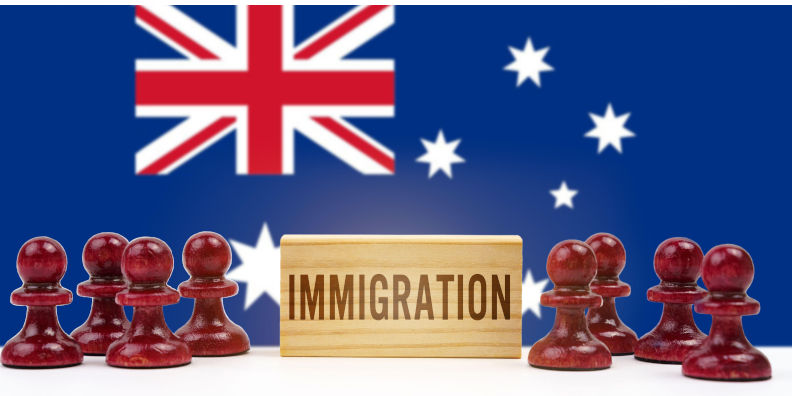Immigration policy and the federal election
April 2, 2025
Peter Dutton is desperate to talk about immigration during the current election campaign. That will largely be about pointing fingers at Labor, sometimes misleading fingers as he did during his budget reply and not providing details of his own policies.
While he says he will provide details soon, the reality is that he will provide as little as he can get away with. Both major parties are desperate to avoid putting out details of their future immigration policies.
A key statement Dutton made during his 2025 budget reply speech was that:
“In its first two years, the government brought in a million people through the migration program.”
This is untrue and as a former minister responsible for immigration, Dutton would know it. In making this statement, Dutton is deliberately mixing up net migration and the permanent migration program. In a set piece speech to Parliament, a mistake such as this is not an accident.
But why would he do that?
In 2022-23 and 2023-24 combined, net migration was indeed approximately a million. A large portion of the blowout was due to policy settings put in place before and during COVID by the Coalition Government. Dutton would not want attention drawn to that or to the fact he has now retreated from his announcement that he would reduce net migration to 160,000. His main remaining immigration policy is to cut the permanent migration program to 140,000; one that does relatively little to reduce net migration. Hence the benefit of mixing up the two.
The Labor Government was too slow to respond to the blowout in net migration. I thought Labor would start tightening policy in late 2022 when it was clear net migration was booming. That it did not may have been due to Treasury forecasts that suggested there was no need to tighten. Those forecasts turned out to be nowhere near the ballpark and may have misled the government. It was not until the second half of 2023 that the Labor Government started to gradually tighten policy, particularly student visa policies the Coalition had put in place.
The migration program in the first two years of the Labor Government was just below 400,000. Dutton would know that, but was happy to mislead on this in his budget reply. Dutton would remember that in September 2022, he said:
“We do need an increase in the migration numbers, but we’ll see what the government actually delivers because this can be many, many months, if not a couple of years, in the pipeline”.
It was not clear whether in September 2022 Dutton was referring to net migration or the migration program needing to be increased, but he would not want the media to dredge this up. If if it does, it is likely Dutton will say he was referring to the migration program (which he now proposes to cut) and not net migration, which he uses to criticise the Labor Government, but on which he no longer has a policy position.
This is despite the fact it is net migration that is key to housing demand, not the permanent migration program, a substantial portion of which comes from temporary entrants already in Australia. Dutton’s suggestion that cutting the permanent migration program by 45,000 would free up 100,000 houses is unadulterated nonsense, yet the media continues to let him get away with that statement.
Dutton did not specifically mention net migration in his budget reply speech. He would know that Treasury has forecast net migration would fall to 260,000 in 2025-26 and 225,000 in 2026-27. While there are significant doubts about Treasury’s net migration forecasts, they leave very little room for Dutton to argue for a cut to net migration, given he now recognises his earlier net migration target of 160,000 would be impossible to deliver without a very weak labour market.
Apart from Treasury assumptions about a rapid and unprecedented (outside COVID) rise in student and temporary entry departures, Treasury is relying on there being no surge in universities recruiting students in the second semester 2025 or first semester 2026. While both parties say they want to cap student numbers at provider level, there is no legal power to do this after Dutton and the Greens opposed legislation giving government that very power.
Why neither party wants to provide details on the 2025-26 migration program
Contrary to standard practice, the Labor Government did not release information on its planned migration program for 2025-26 with the 2025 Budget. That was after it said in its new migration strategy that it wanted to move to longer-term migration planning. It is unlikely to release any details on its 2025-26 migration program until after the election.
Dutton has committed to reduce the migration program from the current 185,000 (plus 3000 permanent Pacific Engagement Visas) to 140,000. It is difficult to see how he will deliver a migration program of 140,000 given:
- the rapidly growing size of the partner visa backlog (likely to be well over 90,000 by end of 2024-25 with only 40,000 places currently available for a visa category that is required by the Migration Act to be managed on a demand driven basis);
- the National Party’s insistence that regional visas cannot be cut (and resurrection of David Littleproud’s demand-driven Agriculture Visa which would turbo charge net migration and largely unmeritorious asylum applications);
- booming demand for employer sponsored visas that have never before been capped (any attempt to cap these would be met with a storm of resistance from business groups);
- Dutton’s desire to increase migration of construction tradies; and
- his commitment to re-introduce the Significant Investor visa (likely to morph into a golden ticket visa modelled on the one recently introduced by the Trump Administration).
There are tough decisions to be made to get long-term net migration down to the current Treasury forecast of 225,000, including managing booming demand in the permanent migration program. It would appear neither party is willing to explain these to the electorate before the election next month.

